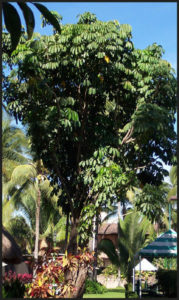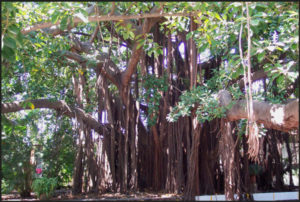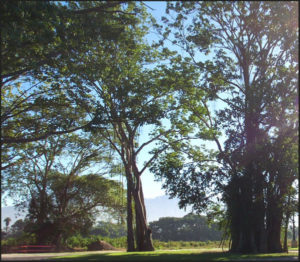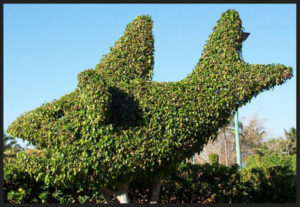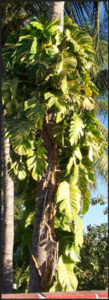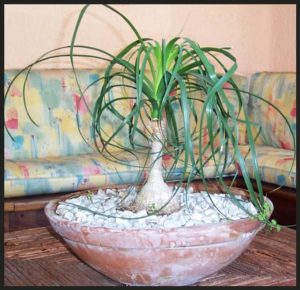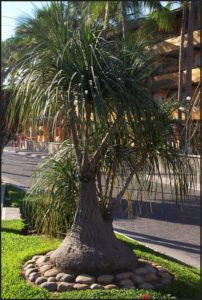The next time you find yourself in a tropical or subtropical zone, take a closer look at some of the large and lovely foliage.
One of the most delightful surprises of any tropical vacation is recognizing familiar faces in new surroundings. When it comes to the familiar “faces” of your houseplants, you may do a double take when you see them in their native habitat.
That little ponytail palm on the kitchen windowsill suddenly is a landscape specimen, and that’s only the beginning. The well-mannered rubber tree in your office, and the schefflera dutifully gracing the corner of the dining room take on new identities in their climate of choice; that of magnificent, enormous anchors of public and private landscapes. Not to mention the reliable little ficus in so many homes and offices. Here, in the tropics and subtropics, unless a talented gardener constrains it through pruning into imaginative shapes, the ficus will grow to impressive, monumental size. The next time you find yourself enjoying the sun and sand on vacation or as a break from business travel, take a moment to look for these sizeable relatives of the familiar houseplants at home, and perhaps come to a new appreciation of the benefits of generous sun and water.
You may have a pot of pothos, that little yellow and green ivy with heart-shaped leaves, on top of the bookshelf. Or you may have added a trellis, so that it may climb to as much as 10 feet tall, filling an entire corner of the room. Once you see it at home in the subtropics, however, that 10 feet doesn’t seem so impressive. It covers the trunks of the highest palms, and each leaf might be 2 feet or longer, torn dramatically by the winds. An efficient air purifier, pothos is easily propagated and well worth cultivating in any climate.
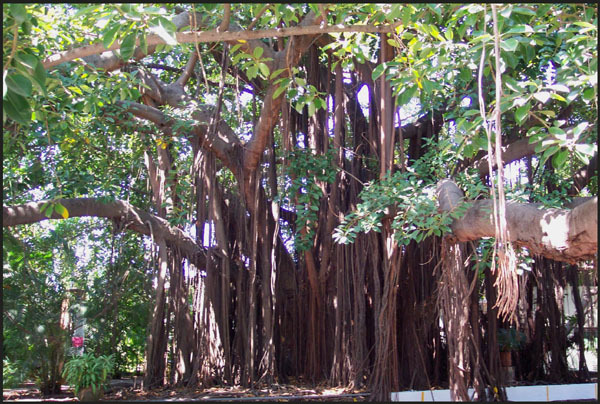
Another tropical giant disguised as a popular indoor plant, or even as a bonsai specimen, is schefflera ( S. actnophylla). A houseplant in cooler climes, it’s a small shrub in Hawaii, and it reaches full tree size of 40 feet and more in Mexico. Its flower stems curve and twist, resembling the tentacles of an octopus, and are covered with red flowers (green in New Zealand).
The Ficus family of 600+ species offers several examples of domesticated houseplants which completely shift personalities, becoming massive trees in the tropics. In this large family are the fiddleleaf fig, the weeping banyan, and the two shown here, Ficus benjamina and F. elasitca. Near the tourist resorts, F. benjamina may be fashioned into a wide variety of topiaries but, left alone with full sun and ample water, it attains majestic heights. The rubber tree is tall, too, to 100 feet, and impressively wide, as its aerial roots reach the ground. Dappled with sunlight, it is truly an awesome sight!
On a smaller, but still impressive scale, the ponytail palm ( Beaucarnea recurvata) migrates from its coffee table post in northern climates to its position as a landscape specimen in the tropics, growing slowly to 30 feet in height. With its bulb-shaped base storing water, and giving it the alternate name of elephant’s foot, it can survive a long dry season, but it has no defense against overwatering, so be a little sparing.
The next time you find yourself in a tropical or subtropical zone, take a closer look at some of the large and lovely foliage. You just may recognize some very familiar faces, after all!

